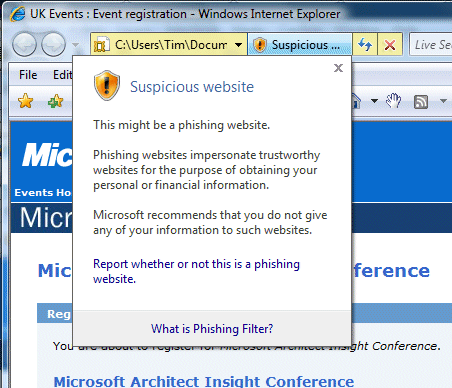He would be hacking (in a good way) with the crowd at the Future of Web Apps conference I attended two weeks ago, not here with a bunch of senior software architects discussing the failures and successes of SOA (Service Oriented Architecture). I’m at the Microsoft Architecture Insight Conference in Wales, where I’ve been hearing a lot about old-fashioned ideas like requirements analysis, making the business case for change, being realistic about software reuse, and other sound, sensible, but unexciting software development principles.
That’s not to say this is a bad conference, far from it. I had an excellent chat with Microsoft’s Jack Greenfield, a Microsoft architect who is putting together the next generation of Microsoft’s modeling and enterprise development tools for Visual Studio. “Software factories” is the buzzword – see here for more background on this. There is also good stuff on identity management within and beyond the firewall, sessions on using development methodologies in Visual Studio Team System; amigo Ivar Jacobson is here talking up his Essential Unified Process (though “process” is last year’s word; we do “practices” now); and a number of case studies including one on visualizing the London Underground network which I’m looking forward to later today – this is the amazing WPF application which was shown off at one of the Vista launches.
It’s easy to find fault with products like Vista or Office 2007; yet you have to give Microsoft credit for establishing .NET as a major platform for enterprise development against considerable JEE momentum.
That said, let’s go back to the young Bill Gates. There is a track here on SaaS (Software as a service), which seems to mean hosted, on-demand applications versus traditional premises-based development. We heard some research on disruptive technology which Microsoft is sponsoring in conjunction with the Manchester Business School, including a look at Siebel vs Salesforce.com for CRM (Customer Relationship Management). Here’s one facet that stuck in my mind. According to Dr Steven Moxley of the MBS, Marc Benioff’s first customers were not SMEs or start-ups, but groups within large enterprises that were frustrated by the shortcomings or inflexibility of their existing software. It was a kind of stealth adoption. Salesforce.com was able to sell to such groups because its software is zero-install, pay as you go.
I immediately thought of the times I’ve had phone calls that go, “Could you send that attachment to my Gmail account. Our email is playing up today.”
Gmail may be less feature-rich than Exchange; but it tends to just work.
In other words, you could as easily do Microsoft vs Google as Siebel vs Salesforce.com. Why is Microsoft sponsoring studies that articulate its own vulnerability? Officially, this is about helping its partners to grown their own distruptive solutions using Microsoft technology; but I also see this as evidence that Microsoft has abundant understanding of the difficulties it faces. What it lacks is any conherent strategy for overcoming them, though there are always hints that some such strategy will emerge sometime “soon”.
I think it might. Gates disrupted IBM; he didn’t topple it. But there is going to be some pain.
Postscript: See also this pertinent post from Zoli Erdos who is looking forward to ditching his desktop software, subject to finding a solution for a couple of unsolved problems:
My bet is on Google or Zoho to get there first. As soon as it happens, I’m going 100% on-demand.
